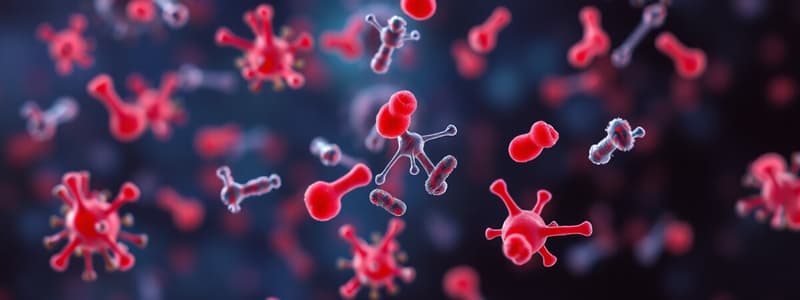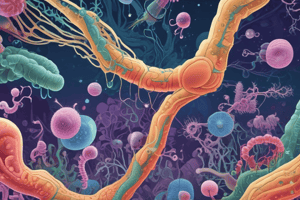Podcast
Questions and Answers
What is the main function of antiserum?
What is the main function of antiserum?
- To transport nutrients in blood
- To bind to specific antigens (correct)
- To produce clones of antibodies
- To diagnose diseases
During the primary immune response, which immunoglobulin is primarily produced?
During the primary immune response, which immunoglobulin is primarily produced?
- IgG (correct)
- IgA
- IgE
- IgM
What characterizes polyclonal antibodies (PAbs)?
What characterizes polyclonal antibodies (PAbs)?
- They are produced from a single plasma cell line
- They are only effective against one type of pathogen
- They are synthesized in the liver
- They recognize multiple epitopes (correct)
What is serum primarily composed of?
What is serum primarily composed of?
Which statement about the secondary immune response is true?
Which statement about the secondary immune response is true?
What type of antibodies does heterogeneous antiserum contain?
What type of antibodies does heterogeneous antiserum contain?
Which animal is ideal for large-scale polyclonal antibody production?
Which animal is ideal for large-scale polyclonal antibody production?
What is the primary role of adjuvants in antibody production?
What is the primary role of adjuvants in antibody production?
What is the first step in the purification of polyclonal antibodies?
What is the first step in the purification of polyclonal antibodies?
Which of the following is used as a precipitant in ammonium sulphate precipitation?
Which of the following is used as a precipitant in ammonium sulphate precipitation?
In immunoaffinity chromatography, how are antibodies immobilized on the Sepharose matrix?
In immunoaffinity chromatography, how are antibodies immobilized on the Sepharose matrix?
Which factor is not considered when designing immunization protocols for antibody generation?
Which factor is not considered when designing immunization protocols for antibody generation?
What is the purpose of using a buffer during immunoaffinity chromatography?
What is the purpose of using a buffer during immunoaffinity chromatography?
Flashcards
Primary immune response
Primary immune response
The initial immune response to a specific antigen, characterized by a lag period of about 7 days before IgG levels rise, followed by gradual decline.
Secondary immune response
Secondary immune response
The immune response after subsequent exposures to an antigen, characterized by a shorter lag period, a faster and larger IgG rise, and a longer duration.
Immunogen
Immunogen
A substance that triggers an immune response, specifically the production of antibodies.
Polyclonal Antibodies (PAbs)
Polyclonal Antibodies (PAbs)
Signup and view all the flashcards
Serum
Serum
Signup and view all the flashcards
Heterogeneous antiserum
Heterogeneous antiserum
Signup and view all the flashcards
Antibody Generation
Antibody Generation
Signup and view all the flashcards
Antibody Purification
Antibody Purification
Signup and view all the flashcards
Polyclonal antibodies
Polyclonal antibodies
Signup and view all the flashcards
Adjuvants
Adjuvants
Signup and view all the flashcards
Immunization
Immunization
Signup and view all the flashcards
Immunoaffinity Chromatography
Immunoaffinity Chromatography
Signup and view all the flashcards
Antiserum
Antiserum
Signup and view all the flashcards
Study Notes
Introduction to Immunoanalysis
- Immunoanalysis is the study of immune responses and the use of antibodies in diagnostic techniques.
Learning Objectives
- Describe the primary and secondary immune responses.
- Define the terms: plasma, serum, antiserum, clone, polyclonal antibody (PAbs), immunogen, and adjuvant.
- Understand how polyclonal antibodies are generated.
Serum, Antiserum, and Cloning
- Serum is the liquid portion of clotted blood.
- Antibodies within serum that bind to a specific antigen are known as antiserum.
- Antibody cloning is the process of producing identical copies (clones) of a specific antibody.
Adaptive (Humoral) Immune Response
- The primary immune response occurs when the host 첫 접촉 with an antigen (Ag).
- IgG levels appear after approximately 7 days, rise rapidly, and then gradually decrease.
- The secondary immune response occurs after subsequent exposure to the same antigen (Ag).
- The lag period is shorter, and the response and duration are longer than the primary response.
Immune Response - Cell Types
- The primary immune response involves short-lived plasma cells.
- A secondary exposure to the antigen leads to memory B cells, differentiating into plasma cells to produce antibodies.
- Long-lived plasma cells found in bone marrow generate antibodies continuously.
Immune Response - Immunoglobulins
- The primary immune response shows an initial increase in IgM and a later increase in IgG.
- The secondary immune response shows significantly higher IgG levels and a faster response due to memory cells.
Polyclonal Antibodies (PAbs)
- Polyclonal antibodies (PAbs) are produced when several different plasma cell lines (clones) produce antibodies against different epitopes of an antigen.
- They are heterogeneous; each clone secretes different antibodies against different epitopes.
Group Activity – Generating and Purifying Abs
- This section describes the process of immunization, a key factor for generating antibodies.
- The purification of Abs.
Polyclonal Antibody Production – Host
- Laboratory-scale production uses small volumes of serum from various animals (e.g., rabbits, chickens).
- Large-scale production uses larger volumes from animals like sheep, goats, and pigs.
- Serum is extracted from animals after immunization with an appropriate antigen.
Polyclonal Antibody Production – Adjuvants
- Immunogens include proteins, polysaccharides, lipids, nucleic acids, conjugates, microorganisms, and mammalian cells.
- Adjuvants enhance sustained immune responses by acting as depots to slowly release antigen.
- Examples include Freund's adjuvant and alum.
Adjuvants Enhance to Production of Abs
- Visual representations of vaccine development with and without adjuvants.
- Immunization process with and without adjuvants.
Polyclonal Antibody Production
- Injecting an antigen into a rabbit triggers a response producing antibodies.
- Activated B cells differentiate into plasma cells, producing polyclonal antibodies.
- Collect antiserum containing polyclonal antibodies from the immunized rabbit.
Polyclonal Antibody Production
- Standard immunization protocols are designed to maximize the immune response.
- Factors to consider include species, form, and dose of immunogen, choice of adjuvant, and immunizations' route, number, and timing.
Polyclonal Antibody Purification
- Purification methods involve concentrating antibodies from serum, typically using ammonium sulfate precipitation.
Purification of Polyclonal IgG
- Purify polyclonal IgG using immunoaffinity chromatography with cyanogen bromide-activated Sepharose.
- Sepharose is a matrix to which the specific target antigen is attached to bind the antibody.
- Unbound materials washed away, antibodies eluted using elution buffer.
Immunoaffinity Chromatography – Antigen
- Antibodies binding to the antigen are retained by the beads.
- Other antibodies are eluted.
- Antigen-specific antibodies eluted with acidic solutions.
Immunoaffinity Chromatography – Ab
- Antibodies are immobilised on a Sepharose matrix, binding to Protein A through the IgG Fc region.
- Other proteins eluted.
- IgG eluted using an acidic solution.
Studying That Suits You
Use AI to generate personalized quizzes and flashcards to suit your learning preferences.




